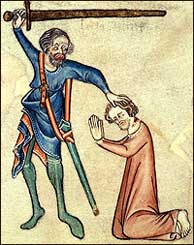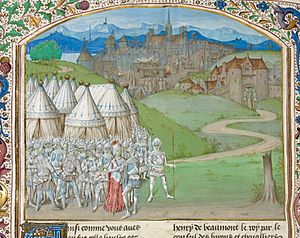Battle of Burton Bridge (1322) facts for kids
Quick facts for kids Battle of Burton Bridge |
|||||||
|---|---|---|---|---|---|---|---|
| Part of the Despenser War | |||||||
 A Victorian photograph of the medieval Burton Bridge |
|||||||
|
|||||||
| Belligerents | |||||||
| Royalists | Contrariants | ||||||
| Commanders and leaders | |||||||
| King Edward II | Earl of Lancaster | ||||||
| Strength | |||||||
| Up to 3,000 men | |||||||
The Battle of Burton Bridge was a fight in 1322. It happened between Thomas, Earl of Lancaster, and his cousin, King Edward II of England. This battle was part of a bigger conflict called the Despenser War.
King Edward's army was moving north. They wanted to fight Lancaster. Edward had already beaten Lancaster's allies in Wales. Lancaster tried to stop the King. He made the bridge at Burton upon Trent strong. This bridge was a key crossing over the River Trent.
King Edward reached Cauldwell on March 7, 1322. He planned to cross the river at Walton-on-Trent. This would let him get around Lancaster's forces. But floods delayed Edward for three days. During this time, some of his soldiers faced Lancaster's men at the bridge.
On March 10, 1322, Edward's main army crossed the river at Walton. They moved to the south side of Burton. Lancaster brought his men out of the town. He wanted to fight the King in an open battle. But he saw that King Edward's army was much larger. So, Lancaster decided to retreat north. The King's men chased him closely. Lancaster was later captured at the Battle of Boroughbridge. King Edward ordered him to be executed.
Lancaster's defeat ended the immediate threat to Edward's rule. But King Edward was still not popular with his nobles. In 1327, he was forced to give up his throne. His son, Edward III, became the new king.
Contents
Why Did They Fight?
Thomas, Earl of Lancaster, had been an enemy of King Edward for a long time. The King often upset his nobles. He gave too much power to his friends, like Piers Gaveston, 1st Earl of Cornwall. Gaveston was even made a temporary ruler when Edward was away.
Lancaster also showed his disapproval by not helping Edward. He refused to join Edward's fights against Scotland. This included the big defeat at the Battle of Bannockburn. After this, Scottish raids on Northern England increased. Edward had to agree to new rules. These rules, called the Ordinances of 1311, limited the King's power. A council led by Lancaster was supposed to govern the kingdom.
Soon after, Lancaster captured Gaveston. He had him executed after an attack on Scarborough Castle. The new council of nobles didn't do much better than the King. They failed to stop the Scots from taking Berwick-upon-Tweed in 1318.
Edward continued to upset his nobles. He promoted young men like Hugh Despenser the Younger. Despenser was known to be an enemy of Lancaster. In 1318, Lancaster met with important church leaders. They met at Horninglow, near Burton upon Trent. These talks led to the Treaty of Leake. This treaty was an attempt to make peace between the King and his nobles.
But this peace did not last long. Despenser's power kept growing. This threatened the lands of the powerful Welsh Marcher Lords. In 1321, Lancaster joined these lords. They openly rebelled against King Edward.
The Battle at Burton
King Edward quickly moved against the Marcher Lords. He defeated them easily. They were not working together. Then, Edward moved north to face Lancaster. The Earl of Lancaster left his base at Pontefract. He went to block the important crossing at Burton. This was a key point on the River Trent.
Lancaster arrived in early March 1322. He had lost many supplies to floods on his way. He began to make the western end of the bridge strong. The bridge was made of stone and had 36 arches. It was about 470 meters long and only 4.5 meters wide.
Lancaster sent men to stop the King from crossing the Trent elsewhere. He wanted to prevent Edward from getting around him. Two of these men were John de Myner and Richard de Holland. They broke the bridges at Wychnor and Hamstall Ridware. De Holland was later fined by the King for this.
Lord Robert de Holland was a close friend of Lancaster. He had gathered troops for Lancaster in Cheshire. But on March 4, de Holland received a secret order from the King. Edward told him to join the King against Lancaster. De Holland seemed to obey. He gathered troops at Ravensdale Park. He pretended these troops were for Lancaster's army at Burton.
King Edward arrived at Cauldwell on March 7, 1322. He planned to use a shallow crossing at Walton-on-Trent. This would let him outflank Lancaster. But the crossing was flooded and could not be used. Edward had to wait for three days. During this time, Edward ordered an attack on Lancaster's strong position. They fought all day, but the King's forces could not break through.
Lancaster waited for help from Holland. Holland had camped with his men about 10 kilometers north of Burton. But Holland seemed to be waiting to see who would win. He did not want to show his true loyalties yet. Holland may have even sent letters to Lancaster. These letters might have been meant to draw Lancaster's men away from Burton.
Edward's troops finally crossed the Trent at Walton on March 10, 1322. They advanced on Burton from the south. Lancaster was now surrounded. He moved his men from the bridge to a field outside Burton. He set fire to the town as he left. When he saw how outnumbered his men were, Lancaster decided to retreat. He also realized Holland was not coming to help him. Edward's men chased Lancaster.
This clash is not officially called a "battle" by some historians. But some people were hurt. Sir Roger D'Amory, who looked after Alton Castle, was injured. He later died from his wounds.
What Happened Next?
The King's troops chased Lancaster. They were led by John de Warenne, 7th Earl of Surrey and Edmund of Woodstock, 1st Earl of Kent. They captured Tutbury and Kenilworth. They also caused damage in Staffordshire and Derbyshire.
Holland saw that the King was winning. He knew the King had put his daughter in the Tower of London. So, Holland openly turned against Lancaster. Holland's men attacked and robbed Lancaster's supporters. They stole valuable goods from people like Hugh de Audley and Lancaster's wife, Alice de Lacy. He also told his men from Cheshire to stop Lancaster's troops from escaping. Holland gave his troops to the King on March 13. But the King did not welcome him. Holland's past friendship with Lancaster led to his imprisonment. He was held at Dover Castle and lost his lands. In 1328, he was killed by an unknown group. His head was given to Lancaster's brother, Henry, 3rd Earl of Lancaster.
Lancaster managed to escape Tutbury Castle in the dark. With many of his soldiers, he avoided Edward's patrols. They crossed the flooded River Dove and went north. After taking Tutbury, Edward ordered D'Amory's dead body to be punished for treason. Lancaster fled north. Sir Andrew Harclay heard of the King's victory at Burton. He moved to fight Lancaster at the Battle of Boroughbridge. Lancaster was defeated and captured by Harclay. He was later executed at Pontefract. King Edward ordered a small chapel to be built on the Burton bridge. This was to remember his victory there.
Lancaster was finally dealt with. But Edward continued to upset his nobles. He went back on his promises to limit his royal power. He kept promoting Despenser. He also lost important battles against the Scots. As Edward became more unpopular, Lancaster's grave became a place where people went to show their opposition to the King. Edward's own queen, Isabella of France, joined her lover, Roger Mortimer. In 1327, they forced Edward to give up his throne. His son became Edward III.
After the Battle
After the battle, the Audley family said they lost many valuable items. These included gold cloth, silver dishes, and church decorations. These items were supposed to be moved to Tutbury Priory. But they never arrived there. They were taken to Tutbury Castle and lost when Lancaster's men retreated from Burton. Burton Abbey also suffered damage from Lancaster's forces.
The leader of Burton Abbey was accused of hiding goods from the King. It was claimed he took Lancaster's money and goods. These were left behind after the battle. The abbot said he only found one silver cup. He gave it to the King. In 1831, many silver coins were found in the River Dove, near Tutbury. These coins might have been part of Lancaster's treasure. This could support the abbot's story.
The next year, King Edward gave the Abbey some land and rights. This was to remember his "glorious victory" at Burton. It was also to help the Abbey.
Local Stories
The battle led to a tradition at Chartley Park. This park belonged to John de Ferrers, 2nd Baron Ferrers of Chartley. The baron had a herd of white cattle with black ears. These cattle came from wild ones found when the park was created. In 1322, an unusual black calf was born in the herd. People said it predicted the Battle of Burton Bridge. It also predicted the downfall of the de Ferrers family. They had supported Lancaster.
Later, people said that if a dark or partly colored calf was born in the herd, someone in the de Ferrers family would die within a year. This was said to have happened before the deaths of several family members. Another local story says that the legendary figure of Robin Hood fought for Lancaster at the battle.




